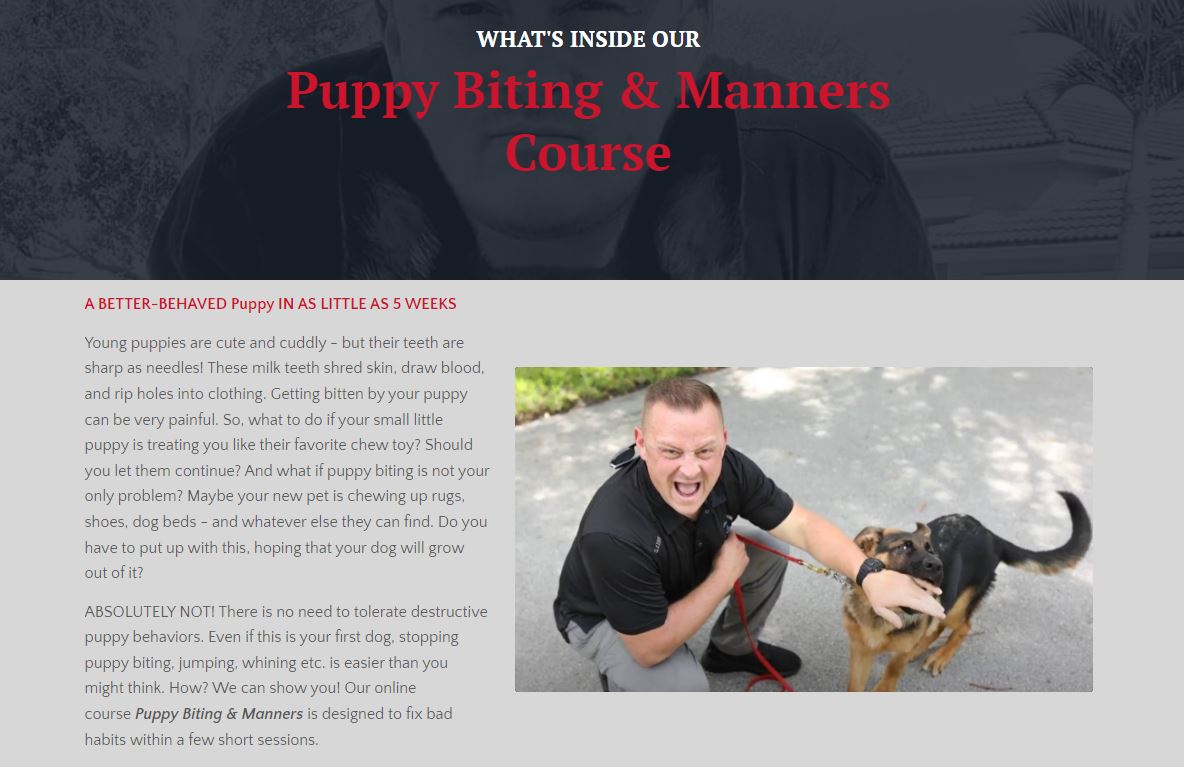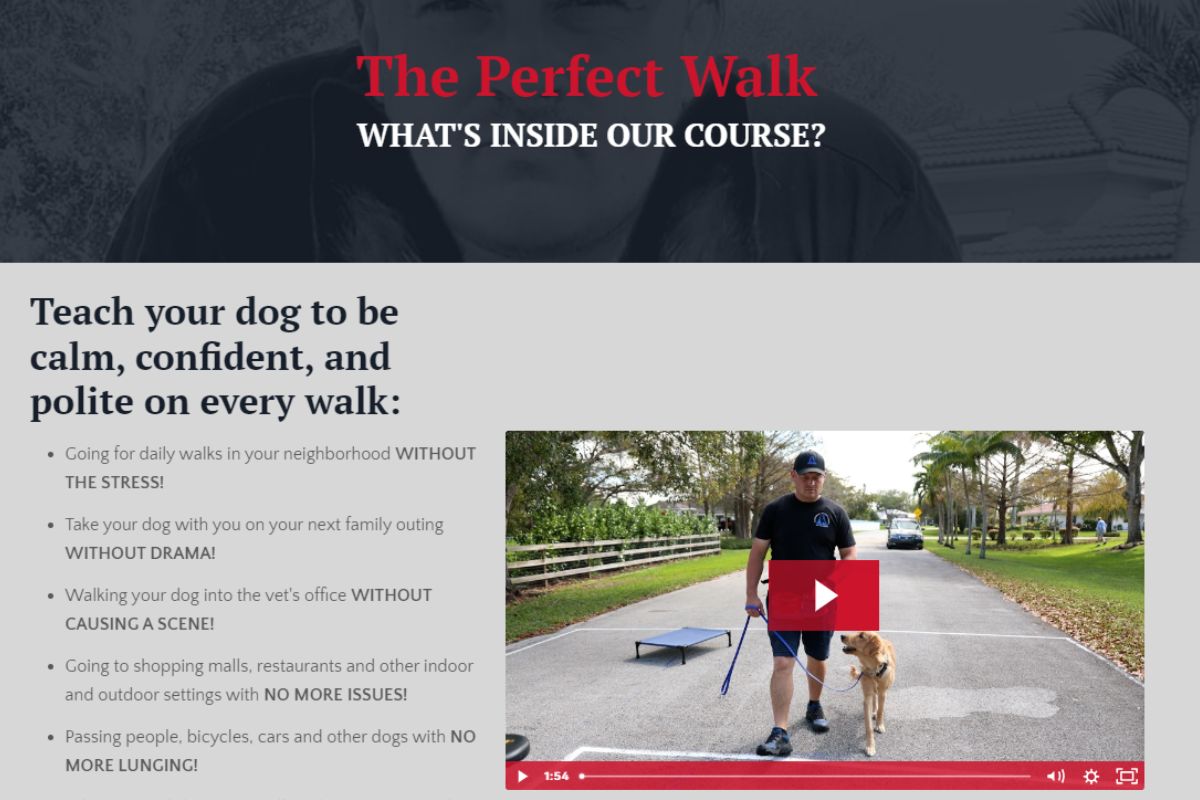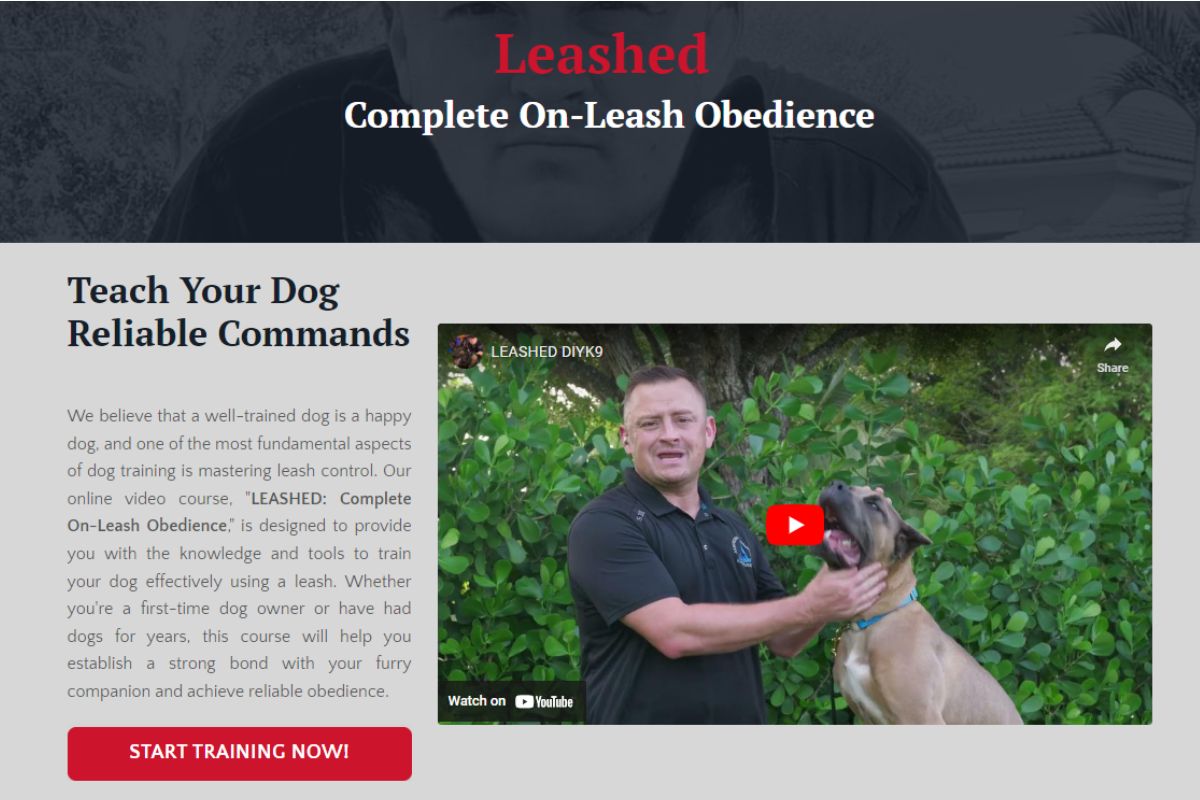Is your dog walking you down the street? Are you tired of yelling commands at her while she looks at you and continues to file her nails? We hear ya’. So, we decided to look closely at a company called DIYK9 to see if what they’re offering is sound, affordable, and helpful to the everyday dog guardian.
DIYK9 is the brainchild of Garret Wing, a credible dog handler and trainer who wanted to share his knowledge of dogs and their behaviors. We had to see for ourselves if this is a program we’d use for our own dogs, so I devoured their website, and this article will show you what I found.
We’re in it with you. We love our dogs immensely and hold on to the belief that the answer to “Can’t we all just get along?” is “Yes!” Let’s get into it.
Brief Background
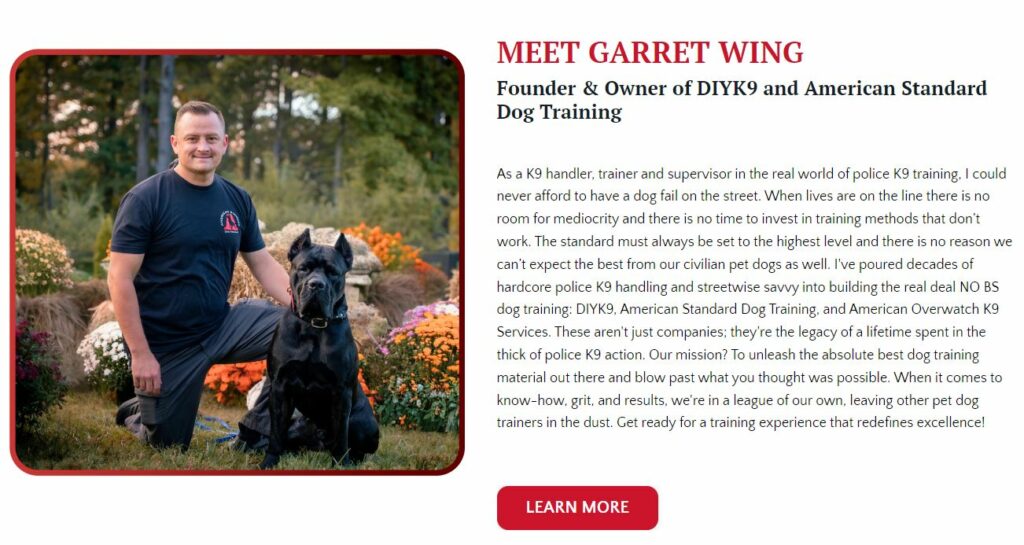
Garret Wing was born to be a dog trainer. His father was a police K9 handler, and he witnessed the process for his first 18 years. That was when he became an EOD (Explosive Ordinance Detection) K9 handler. From there, he trained dozens of dogs of different breeds, sizes, and temperaments by the time he was 20 years old.
His work continued as he became a K9 law enforcement officer and tacked on 20+ years of experience training police dogs. He also started American Standard Dog Training and American Overwatch K9 Services businesses. One of his passions is to make it possible for every dog owner to enjoy a well-trained companion.
To say he is qualified to share successful dog training techniques would be an understatement. His list of accomplishments working with dogs reads like a Cesar Milan résumé. He obviously knows his way around the dog training industry.
One customer shares that DIYK9 methods have taught him everything he needed to know about training his new puppy. Another writes that on top of the course, the community interaction and live chats have been invaluable in helping him set up completely for success.
Another customer calls Wing “The G.O.A.T.,” And yet one more says, “The amount of knowledge, transparency, and experience… is unmatched.”
So far, so good. Now, let’s move on…
DIYK9 Reviews
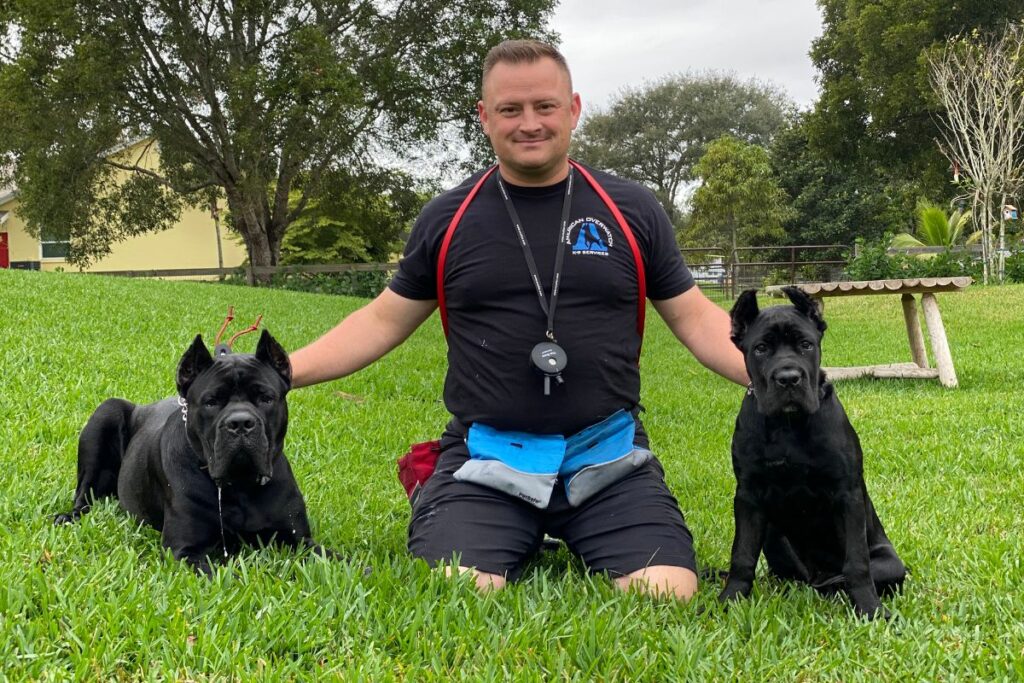
Pros
- All training is reward-based with positive reinforcement, which is the only type we would support/endorse.
- The founder’s experience and knowledge base are through the roof to make him appear credible and reliable.
- There is a 30-day money-back guarantee – ample time to see if the techniques are working.
- The teaching/training is delivered by Garret himself via video.
- DIYK9’s website is thorough, comprehensible, and professional. (They could tweak a few things though.)
- This article in the New York Post gives Wing credibility. (He mentions three dog breeds that can be prone to aggression but, with extensive training, can become the best dogs ever.)
- There are many testimonials from dog owners given for each available course.
- The website lists pricing upfront for each course, so you’re not scrolling ad nauseam to find out how much it costs.
Cons
- There are only a few testimonials on the home page. We’d like to see many more.
- The Premium Membership is quite pricey at $1,499 + $99 monthly (but do consider the sum of each course – listed below – is $1,695 + Unleashed – 5 Steps to E-collar Mastery valued at $697).
- The Premium Membership is subscription-based ($99/Month on top of the $1,499 price).
DIYK9 Training Courses by Garret Wing
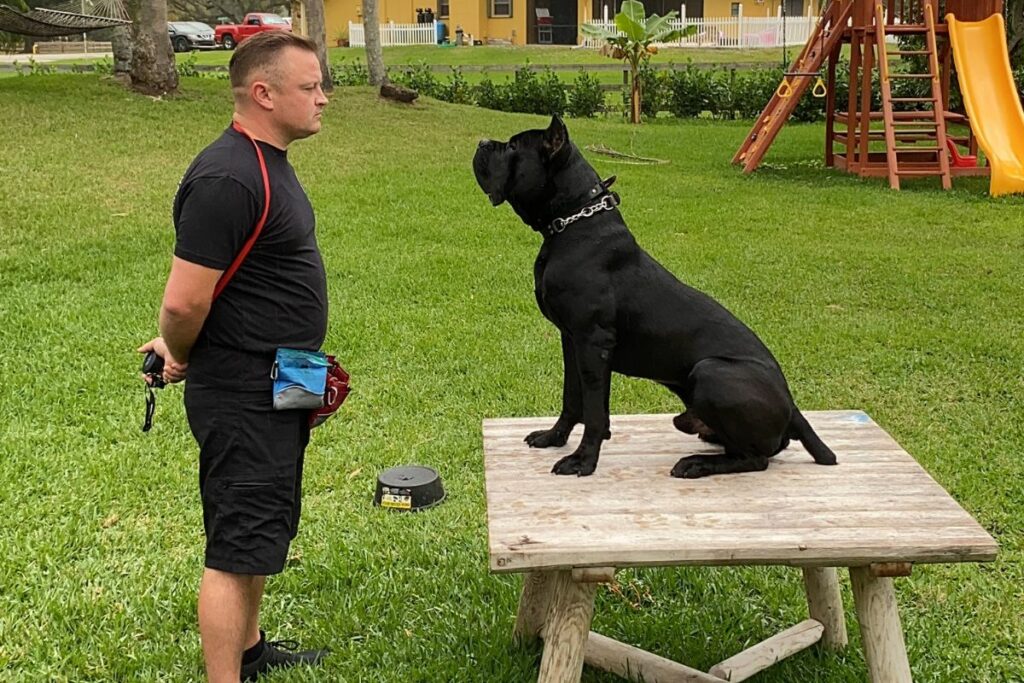
Note: Teaching/Training is for dogs of all ages, breeds, and personalities.
OBEDIENCE 101
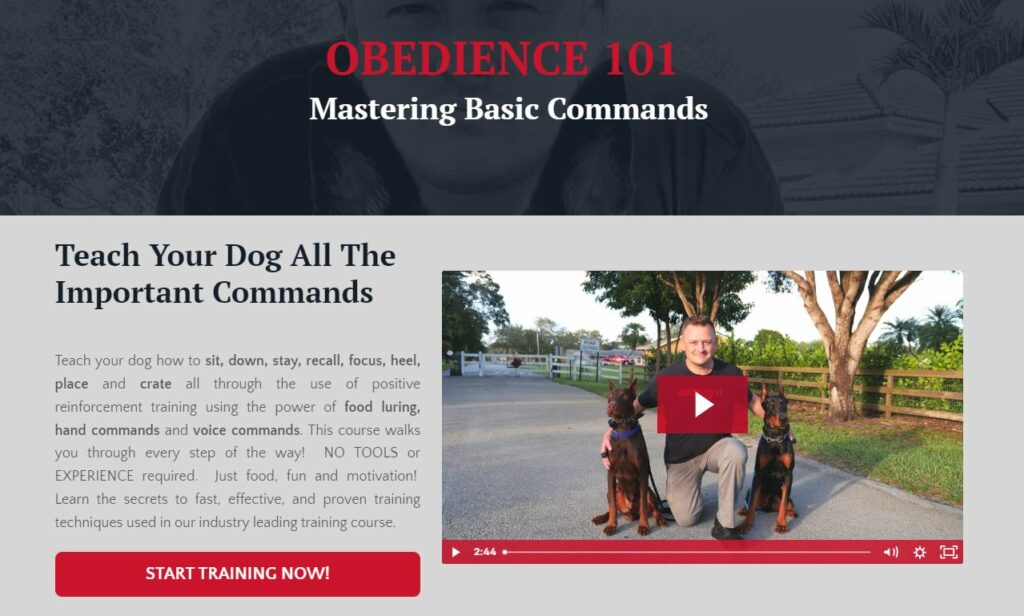
This is reasonable for what is being offered. A trainer, in general, would probably cost much more. Plus, you will teach the course to your dog, which is the best way to train. You’ll learn how to teach your dog all basic obedience commands: Sit, stay, recall (getting them to come when you call), focus, heel, place, and crate.
Beginners to professionals can learn from this course since food luring, hand commands, and voice commands are broken down for you. (Professionals may also not know how to use all three processes.)
Puppy Biting and Manners

Great price. This course is designed to help you “…fix bad habits [of your puppy] within a few short sessions.” It gives you instructions on how to fix common puppy issues like biting, barking, chasing things, chewing, and jumping.
Puppy Essentials Bundle

This is an excellent price to teach you a step-by-step process on how to raise a puppy. You’ll get access to 30+ classrooms and live human demonstrations. The Puppy Essentials bundle sounds like a sound investment to have an even more perfect puppy. (They’re all perfect little cutie-bugs.)
Crate Training

Wonderful price since keeping your dog safe and happy is priceless. Their crate training guide comes with instant, lifetime access and covers:
- What size crate do you need
- Where you should place the crate
- Discovering if or why you can leave your pup in the crate at night
- How to stop your puppy from crying in the crate
- How long you should leave your dog in their crate
- What to do if your dog refuses to enter the crate
Potty Training

Fantastic price for saving your rugs, carpet, and sometimes even bed. (Ew.) Some might think this portion of the training will take weeks, even months, but DIYK9 says your darling dog (“ANY dog”) will have potty training down in 48 hours. Tall order, but I’ve seen it happen with my own dogs, not using any professional training but my own. It’s certainly possible.
The Perfect Walk
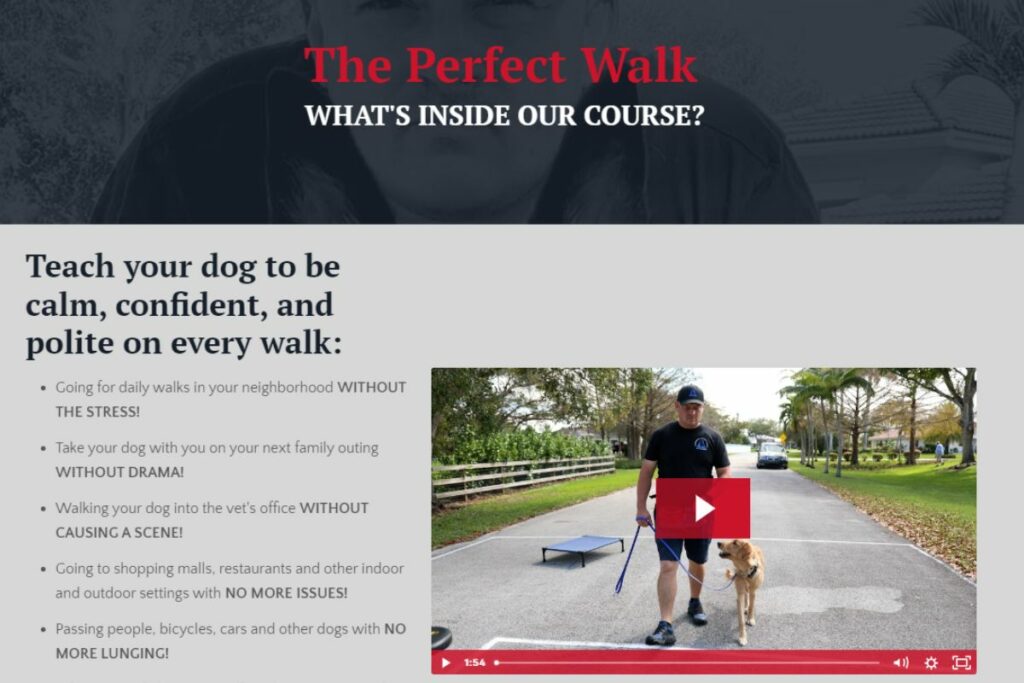
Another great price for teaching you how to safely, conveniently, and easily walk your dog. Includes:
- 30+ instructional videos
- Covers all equipment needed
- Step-by-step process on proper leash walking techniques
- Teaches you how to teach them not to pull on the walk and what to do if you encounter a loose dog
Leashed

This is a bit pricier than other DIYK9 courses (except for Obedience 101), but still, learning how to control, teach, and train your dog while on leash is a superb skill. The price isn’t excessive. The course gives you the knowledge and tools to train your dog effectively and achieve reliable obedience using a leash.
Refund Policy

There is a 30-day money-back guarantee if you find the program doesn’t work for you and your precious one. DIYK9 offers further support by giving you an email address (on their warranty page) to contact them if, for any reason, you are not completely satisfied with:
- Any of their products
- Any of their online training courses
In their own words: “If you don’t experience a significant improvement in your dog’s behavior within 30 days, we’ll refund your investment in full, no questions asked.”
“However, we do not offer a refund for monthly or annual recurring memberships or subsequent renewals.”
Also, they reserve the right to refuse a refund or exchange if you’ve watched more than 10 video lessons cumulatively within the courses or have exceeded the 30-day refund period.
What you can do is purchase individual classes, like those mentioned above, to see if you’re getting results. If so, you may want to invest in their monthly or annually recurring memberships. (You can cancel at any time.)
DIYK9 Monthly Membership (Subscription-based programs)
COST: $24.99/Month
- Instant access to “The Perfect Walk”
- Monthly live Q&A sessions and training demonstrations
- Access to the Community Forum and private Facebook group
And more.
DIYK9 Annual Membership
COST: $16.99/Month
- Includes everything in the monthly membership, plus access to Director’s Cut videos
DIYK9 Premium Membership
COST: $1,499 (one-time) plus $99 monthly thereafter
- Gives you access to everything included in the monthly and annual memberships
- Access to all of their courses, including Unleashed – 5 Steps to E-collar Mastery ($697 value)
NOTE: I was unable to find details on what the E-collar actually does.
- Over 50 hours of private, live Q&A sessions
- A “vault” – over 75 hours of Q&A sessions – of relevant information available for you 24/7
- Networking opportunities with other purchasers
- Private training videos of actual dogs being trained from basic commands to advanced behavior training
How Other Top Online Dog Training Courses Compare
Discover how the other leading online dog training courses stack up against DIYK9.
Other Dog Training Courses Online
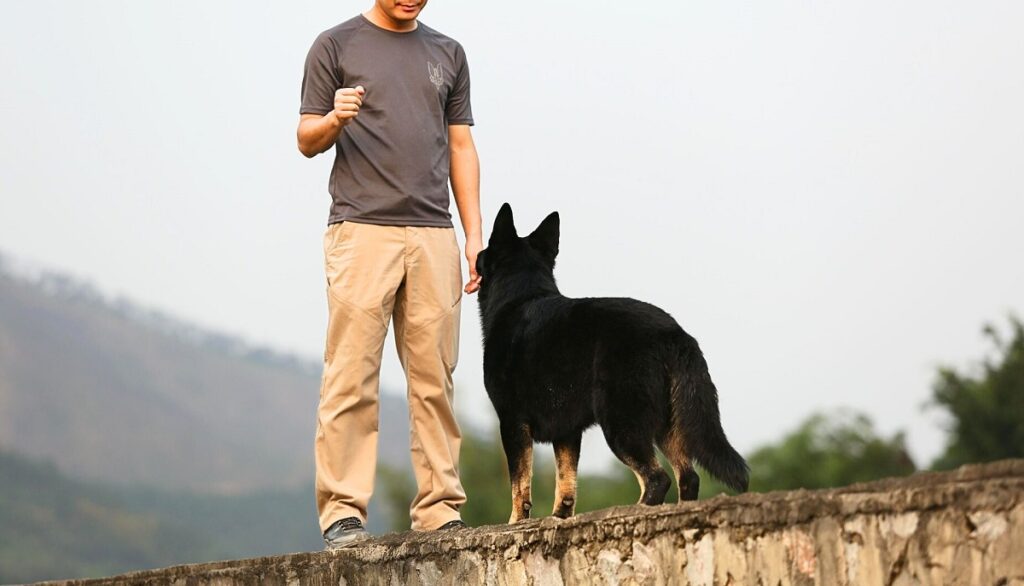
1. K9 TRAINING INSTITUTE
10-week training program – $497 – 90-day money-back guarantee
High points: Offers a free workshop; Donates a percentage of their earnings to support the ASPCA, among other animal welfare organizations; Gives thorough dog breed information for you to choose which is best for you
Drawbacks: Their “About Us” page is too brief and doesn’t give enough background information on their two trainers compared to DIYK9. Their free workshop will certainly include a significant CTA (call to action) somewhere in it.
Regarding their program, the $497 cost includes:
Ten weeks of personal coaching from their training experts
Includes instructions on how to derail:
- Barking
- Leash pulling
- Not coming when called
- Jumping on people
- Running out the door
- Chasing cars or animals
- Chewing
- Nipping or biting
- Begging
- Getting too excited
- Ignoring commands
- Bonus: How to Housetrain Your Dog
- Bonus: Cure Your Dog’s Separation Anxiety
- Bonus: How to Get Kids to Interact with Your Dog
2. ZAC GEORGE’S DOG TRAINING REVOLUTION
Book (and website) – A comprehensive guide that covers everything you’ll need to know to raise, train, and care for your pup. You’ll also find oodles of free videos on YouTube on topics ranging from puppy basics to advanced tricks. Zak is supposedly the #1 most subscribed dog trainer on YouTube.
HIGH POINTS
Hundreds of thousands of people have “Liked” him on YouTube. That says a lot about his techniques. If you prefer reading to watching a video, this is an inexpensive way to go.
DRAWBACKS
If you’re not into teaching your dogs “tricks,” and I’m not, there may be a lot of unnecessary information you’ll need to sift through. There’s not as much networking support, although you could “talk” to other dog guardians via DM.
I believe there’s more meat to DIYK9.
3. SIRIUS DOG TRAINING
Offers dog training classes in the San Francisco Bay area, but you can also purchase different training programs from their online affiliate, The Top Dog Academy. (Navigatable from the SIRIUS website)
Dr. Ian Dunbaris one of the world’s most respected experts on dog training and behavior. In 1982, he designed and taught the world’s first off-leash puppy socialization and training classes – SIRIUS® Puppy Training.
TOP DOG ACADEMY HIGH POINTS
They offer 20 dog training courses that target mainstream needs like obedience training, house training, puppy training, etc. They’re organized, knowledgeable, and experienced in teaching dog handling and training.
DRAWBACKS
My hackles rose when I read they offer a class called The Treatment and Prevention of Dog Aggression: Biting and Fighting and Dog-Dog Reactivity Workshop. I’ve trained over 100 dogs, founded an animal sanctuary, and have been a student of the dog world since I was a little girl. I know what a dog’s body language means.
My experience has been that if you have a dog who has aggression issues, it’s paramount to find a dog behaviorist/trainer to help you help them. It’s dangerous to try to curb dog aggression against humans or other animals if you’re not properly trained by watching some videos.
Is DIYK9 Worth Buying?
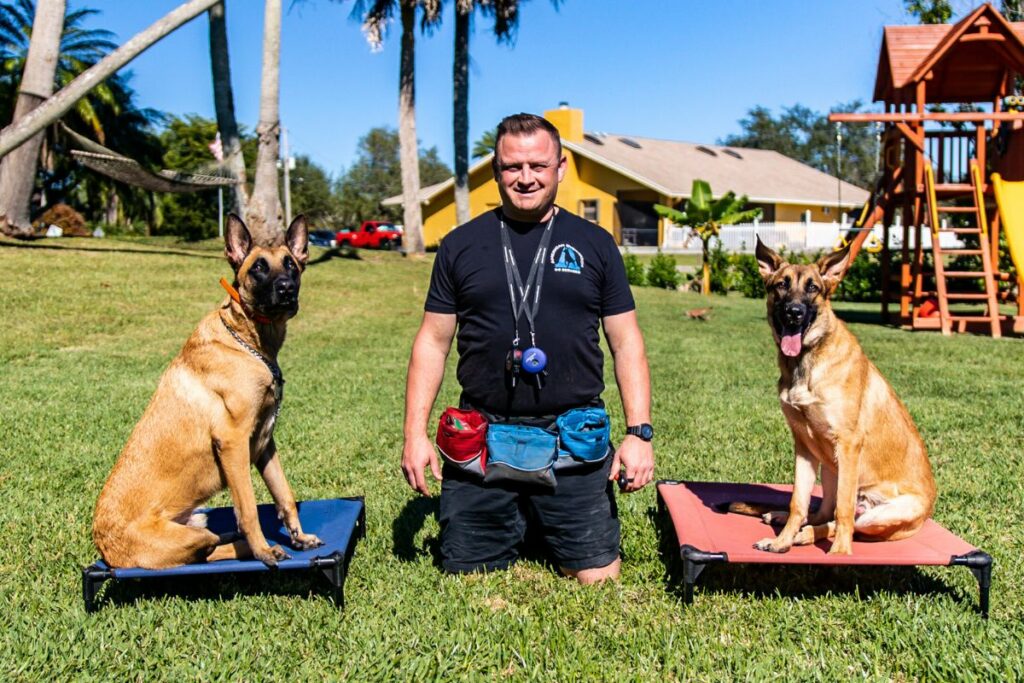
Absolutely…
If you are willing to put in the work, time, and patience it will take to train your dog, this course is a prime investment. The training you will receive goes above and beyond the costs.
However, if you want to access the materials and think the trainer will do the work for you, these courses aren’t worth the investment. It’s your decision to realize that you’re in charge of whether your dog leads a happy, well-balanced life or one that is chaotic and dangerous.
As a dog expert, I believe what DIYK9 is offering is well worth what it costs. The value is phenomenal. One caveat: The website could be more efficient. I really had to dig to find some answers I was looking for.
This online training course would be wonderful for the better portion of dog guardians but not for everyone. If you have an aggressive dog, one who bites or attacks, or is highly traumatized, 1-on-1 training with an experienced dog behavior specialist will most likely be necessary.
Additionally, I know how exhausting it can be to try to contact online companies if I’m not satisfied with their product(s), so having a DIYK9 email address is a real bonus.
Online Dog Training vs In-Person Dog Training
If your schedule or ability to make it to an in-person dog training course makes it almost impossible for you to be there, online dog training could be your answer. There are pros and cons of in-person training courses as well.
Pros and Cons of In-Person Dog Training Courses
Pros
- Being able to socialize your dog with new animals, people, and experiences
- Being able to ask a professional questions about training in real time
- Being able to form relationships with people and their dogs in person
Cons
- Not getting enough 1-on-1 training in large classes
- Limited training subjects – Only obedience training
- Necessary to travel
Pros and Cons of Online Dog Training Courses
Pros
- Information received is usually more comprehensive, and there’s a host of choices for training exercises (Not only obedience training and/or dog “tricks”)
- Ability to reach top national and worldwide dog training experts
- Ability to talk to people all over the world who may have the same difficulties you’re facing with your dog
- You get to work on your timeline and not someone else’s.
- Not necessary to travel
Cons
- The prices could be higher.
- Trainer’s inability to see you and your dog in person
- Less likely to have the ability to ask real-time questions
FAQs
Can I See Improvements in My Dog’s Behavior With DIYK9 Courses, and How Long Does It Typically Take?
Depending on the course, it could take you a matter of hours to a couple of days or longer to achieve impressive results. If you don’t see improvements, DIYK9 offers a no-questions-asked, 30-day money-back guarantee.
Are the DIYK9 Courses Suitable for All Breeds and Ages of Dogs?
Yes. They’re also suitable for the no-experience dog guardian or the trained one.
What Kind of Support Does DIYK9 Offer During the Training Process?
This list depends on which subscription you’ve purchased:
- Founder Garret Wing provides dozens of videos displaying the training methods he uses, which depend on the course(s) you’ve chosen.
- 30+ classroom and live human and canine demonstrations (including puppies)
- Live monthly, interactive Q&A sessions
- Network with other community members
- Weekly “Lives” with Garret Wing
- Lots of online articles – Wisdom on tap, 24/7.
How Does DIYK9 Ensure the Training Methods Are Humane and Effective?
DIYK9 only offers positive reinforcement training methods which means there are no physical punishments or inhumane methods within their training courses. As far as being effective, the money-back guarantee would cover costs if you find it’s not.
Final Thoughts
There’s not a lot of negative things to say about DIYK9. They lay out:
- Exactly what they offer
- More than adequate descriptions and experience of the founder
- What can and cannot be done when dog training
Transparency, experience, and affordability go a long way in my book. I’m ready to jump in myself. I just need to pick up some more Scooby treats.




